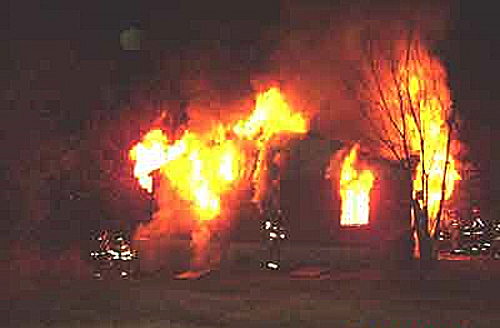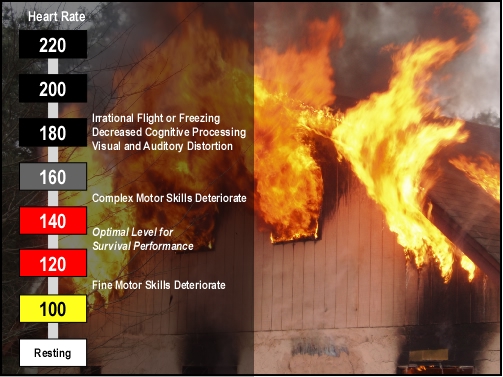Battle Drill
The Problem
NIOSH has investigated a number of incidents in which firefighters trapped by rapid fire progress did not take appropriate survival action. Last September, I was reading NIOSH Report F2007-02, which outlined the circumstances surrounding the death of Firefighter Steven Solomon in Atlanta, Georgia. Firefighter Solomon was severely burned after being caught by rapid fire development while advancing an attack line in a vacant structure (see Figure 1).
Figure 1. Rapid Fire Development

Note: Atlanta Fire Department photo from NIOSH Report F2007-02
Firefighter Solomon was on the nozzle as the first arriving truck removed the plywood covering the front door and thick, black smoke came rolling out the top of the doorway. Firefighter Solomon and the crew of Engine 16 advanced the line into the building as the truck continued horizontal ventilation. After advancing a short distance, fire conditions quickly worsened and the crew attempted to back out, but collided with another company who was advancing a backup line. After exiting the building the crew of Engine 16 realized that Firefighter Solomon was still inside. Crews outside the door on Side A observed the silhouette of a firefighter running through the flames inside the building.
As I read the report, I asked myself how a firefighter on a hoseline that was just a short distance could have been killed by rapid fire development. The NIOSH report identified four contributing factors:
- Initial size-up not conducted.
- Failure to recognize the signs of an impending flashover/flameover.
- Inadequate communication on the fireground.
- Possibility of ventilation induced rapid fire progression.
While these factors likely contributed to Firefighter Solomon’s death, I still did not have a solid answer to my question of how a firefighter on a hoseline just a short distance inside the doorway could have died in this type of event.
Predictability
The best way to avoid being injured or killed in an extreme fire behavior event is to read the fire, anticipate likely fire behavior, and control your operating environment. A majority of our effort should be spent on mastering these skills.
There is no unpredictable fire behavior. Under the same conditions, a compartment fire will develop and behave consistently. However, conditions are not always the same! In addition, firefighters operate with limited information, imperfect skill in anticipating likely fire behavior, and often under pressure to take rapid action. When making decisions under pressure, in a complex and dynamic environment, and with limited information, potential for error increases.
Improved understanding of fire dynamics and development of a high level of skill reduces, but does not eliminate your risk of encountering extreme fire behavior. When this occurs it is essential that firefighters understand the fire behavior, their own reactions to stress, and have well practiced (to automaticity) responses to increase the chance of survival.
Training for Survival
What exactly are firefighter survival skills? Firefighters may encounter a number of life threatening problems while operating in the hazardous environment of as structure fire. Threats include breathing apparatus emergencies (e.g., malfunctions, running out of air), becoming disoriented, and being trapped by collapse or rapid fire progress.
A quick survey of survival skills training programs from around the United States shows a fair degree of consistency in curriculum content:
- Emergency Communications Procedures (Mayday, Radio Emergency Distress Button)
- Personal Alert Safety System (PASS) Activation
- Reorientation, Searching for an Exit & Following a Hoseline to Safety
- Air Conservation Techniques
- Assuming a Horizontal Position to Enhance Thermal Protection and Audibility of the PASS
- Escape to a Place of Refuge
- Use of Visual and Audible Signals (Flashlight, Tapping with a Tool)
- Reduced Profile Maneuvers to Escape Through Small Openings
- Emergency Window Egress (Ladder Bail, Rope Systems)
These techniques may provide useful in dealing with a number of the threats that may be encountered in a structure fire. Taking refuge in an uninvolved compartment (with the door closed) may buy time for firefighters to escape through a window. However, the other elements will have little impact on increasing survival potential when encountering extreme fire behavior phenomena.
What is the missing element in the typical survival skills curriculum? In some cases, firefighters are taught breathing techniques to control their respiratory rate and conserve air, but little emphasis is provided on the psychological and physiological effects of the stress encountered in life threatening situations. This is critical to survival regardless of the nature of the threat. When faced with extreme fire behavior, particularly wind driven flames, flashover, and flash fire, appropriate nozzle technique and immediate tactical withdrawal to a safer area is absolutely critical. However, most survival skills curriculums do not address these critical skills.
When was the last time you practiced withdrawing a hoseline while operating the nozzle in the context of offensive, interior firefighting operations?
Performance Under Stress
There has been little if any research has been done to identify factors influencing firefighters’ performance under the extreme stress of a life threatening situation. However, there has been considerable investigation in other domains, particularly in the military and law enforcement
Increased psychological and physiological arousal prepare the human body for action. As this occurs, the sympathetic nervous system increases heart rate and blood pressure to maximize the body’s physical capacity. However, extreme levels of stress can result in significant deterioration in performance.
In On-Combat: The Psychology and Physiology of Deadly Conflict in War and Peace, LT COL Dave Grossman (2008) identifies five levels of arousal designated Conditions White, Yellow, Red, Grey, and Black. While cautioning against fixing specific heart rate numbers (or other precise physiological measures) to these levels of arousal, heart rate can be used as an indicator (see Figure 2).
Figure 2. Effects of Hormonal or Fear Induced Increases in Heart Rate

Note. Adapted from On-Combat: The Psychology and Physiology of Deadly Conflict in War and Peace (p. 31), by Dave Grossman, 2008, Millstadt, IL: Warrior Science Publications Copyright 2008 by David A. Grossman.
When face with an immediately life threatening situation, the resulting stress can significantly impact an individual’s ability to respond appropriately. In addition to the physiological responses (e.g. increased heart rate, visual and auditory distortion) decreased cognitive processing may delay appropriate response or result in freezing, with the inability to act (Wallenius, Johansson, & Larsson, 2002).
Recently a colleague related the experience of a firefighter who had been trapped by a wind driven fire. The firefighter dropped to the floor, went into the fetal position, said goodby to his wife and children and thought he was dead. Fortunately, the firefighter was rescued, but this illustrates the potentially incapacitating effects of stress in life threatening situations.
What is the answer? Military research points to the need for a highly trained (to automaticity) response. Battle drills integrate these immediate individual actions in the context of small unit operations.
Battle Drill
In a military context, battle drills are an immediate response to enemy contact that requires fire and maneuver in order to succeed. Battle drills are initiated with minimal commands from the unit leader. Soldiers or marines execute preplanned, sequential actions in response to enemy contact.
The battle drill concept has direct applicability to training firefighters to react appropriately on contact with our enemy (the fire) which requires fire (application of water) and maneuver (movement to a safer location) in order to succeed.
Unless a barrier (such as a door) is available to block the flow of flames and hot gases towards the firefighters position, attempts to escape without protection from a hoseline are likely to fail as fire can spread far more quickly than you can move.
Remember: The key elements of a battle drill are fire and maneuver! This requires the ability to operate and maintain control of the hoseline while moving backward.
The next post in this series will return to hose and nozzle drills with development of a battle drill for response to rapid fire progression.
Ed Hartin, MS, EFO, MIFireE, CFO.
References
Grossman, D. (2008). On-combat: The psychology and physiology of deadly conflict in war and peace. Millstadt, IL: Warrior Science Publications.
Wallenius, C. Johansson, C. & Larsson, G. (2002). Reactions and performance of Swedish peacekeepers in life-threatening situations. International Peacekeeping, 9(1), 133-152.
Tags: deliberate practice, Extreme Fire Behavior, Fire Behavior Training, Fire Control, firefighter injury, firefighter LODD, situational awareness



February 7th, 2010 at 17:02
Thanks for sharing another very interesting, thought provoking article Ed.
It prompted me to recall a story related to me a few years ago when we were conducting a CFBT Instructor’s course. One of the course participants (an intelligent, keen, dedicated firie) relayed a story of where he had become trapped and disoriented in a room as it approached flashover and responded in much the same way as did your colleague recently. He curled up on the floor and accepted that this was his fate. Luckily like your friend, he was rescued by other firefighters on scene. The incident pre-dated the implementation of CFBT in our Brigade but stuck with me as an illustration of how the stress of a life threatening situation impaired this very good firefighter’s cognitive function to such an extent that he considered himself totally out of options.
I think this article also ties in very well with one of your previous blogs where you focussed on the need for fidelity of training for the training to be effective.
Again, thanks for prompting us to think about some of the things we may not normally turn our mind to in the course of our training and firefighting.
February 9th, 2010 at 00:53
Following the military roots of “This is my nozzle. Very interesting concept,It reminds me some survival skills we had to learn and put in practice during the terrorism times back in the 80-90´s here in Peru. They work!!,I can assure you that by first hand experience.I´ll be waiting for the nozzle drill to add it to the ones published before and now in practice here in Lima.
February 21st, 2010 at 07:49
hello Ed,
very interesting article.here is the link to the french translation:
http://chezfireball.blogspot.com/2010/02/plan-de-bataillepartie-1.html
February 25th, 2010 at 06:27
Interesting. I’ve made tactical docs starting from this point of view, a few month (year) ago. It’s seem to be useful to read more complex books, like “Achtung Panzer” (Guderian), or “Infanterie greift an” (Rommel). Also “le fils de l’épée” (Charles de Gaule)is a good way to understand modern war.
In fact, you can also work using Project Management system. Because you’ll see that size-up is the main problem ’cause it create a “small question”: what are doing FF during the size-up? In a high level fire service with a strong discipline, the guys stay in the truck, and the chief can really perform a size-up. In small companies, where each fire is a kind of feast, as soon as the truck stop, everybody start to run. So the chief has only 2 choices: 1) avoid size-up or doing it very quickly (so a kind of race between him and FF) 2) doing a good size up. But in this case, at the end of the size-up, the chief had a tactic he can’t apply, due to the fact than a lot of action has been made by the guys and that these actions are not always compatible with the tactic the chief want to apply.
Best regards
Pierre-Louis
March 4th, 2012 at 16:32
[…] battle drills for tactical withdrawal and abandoning the building (depending on conditions). See Battle Drill, Battle Drill Part 2, and Battle Drill Part […]